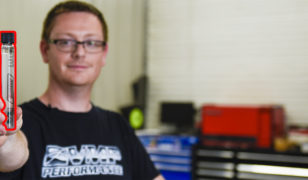In the world of forced induction tuning, extracting the best from your setup depends heavily on your fuel delivery system, fuel quality, and the pulley size you are using.
Altering any one of these three factors will influence how much power you can make. In this article we’ll lay out – in serious detail – just how important each factor is.
How Much Impact Does Bad Fuel REALLY Have?
You may be tempted to save a few dollars by using lower-octane fuel in your car, but once you see the weak results the VMP Performance team got when running their supercharged Mustang GT on 87 octane, you might change your mind.
In the video above our 2024 Ford Mustang GT is fitted with a VMP Gen 6 Stage 2 Supercharger kit. In ideal conditions you should see a gain of over 350 wheel horsepower over a stock Mustang GT. That should translate into around 750 hp on the dyno, but not if you are using subpar fuel.
To prove just how bad low-quality fuel is for your performance car, the Mustang GT was filled with 87 octane and then tested on the dyno.
- The first few runs on 87 octane yielded between 567 and 590 hp, with torque peaking at 512 lb-ft.
- Even adding a few shots of Boostane only had a marginal effect on the results.
Low octane increases engine and exhaust temps and pulls back the timing. This results in less power and potential engine damage at consistent high revs.
Next up was a whole bottle of Boostane and a road drive to allow it all to mix in. The next few dyno runs were far more impressive. Despite the power-sapping 93-degree heat, the Mustang GT was now making 700 hp and 560 lb-ft with 93 octane.
To double-check the data, the next step was to run the car dry and fill it with pure 93 octane.
Putting 93 Octane To The Test
In similarly high ambient temperatures, the Mustang GT was pushing out 728 hp at the wheels along with an impressive 599 lb-ft of torque.
Compared to the 87 octane runs (using the same 5th gear data), that’s an improvement of 110 hp and 87 lb-ft. No tuning, no additional mods, just good old 93 octane fuel.
Now you may be wondering, if 93 octane on its own can deliver such good results, what will a shot of Boostane do? The VMP Performance crew had the same idea, and tried exactly that.
- The car made 743 hp, not a big improvement, but the major change was the smoothing out of the knock sensor data.
- With the Boostane, the ECU allowed the engine to run smoother and with far less intervention.
Upping the Boostane levels further yielded even smoother power delivery, but the peak figures remained just above 740 hp. For high-quality 93 octane fuel, Boostane offers an additional buffer that lets you add more boost without worrying about timing being pulled back. So, make sure you are running the best possible fuel before trying to get more power out of your modded Mustang.
And remember that Boostane (or similar octane boosters) can help mitigate the damage of bad fuel or low octane in the tank, giving your tune some breathing room, but it’s not a substitute for poor quality fuel.
Fuel Systems & Pulleys – The Big Picture
What’s going to determine how much power you can get from these cars is how much air and fuel you can push through the engine.
Changing the pulley size on your supercharger alters how much air you can force through the engine. But pushing up boost without using good-quality fuel or an additive will result in pulled timing and lower power figures.
For the best results using E85 is the way to go. But you need a fuel system that can handle the 85% ethanol/15% gasoline blend.
Check out this video on an S550 generation Mustang GT running E85. It ran a very respectable 726 hp and 582 lb-ft of torque on the dyno running 93 pump gas:
The next step is to install VMP’s own Plug-and-Play Return-Style Fuel System. It is available for certain Mustang GT models and is designed to support E85 and race gas. Running the same pulley and with no mods to the ECU, the car was put back on the dyno. The result?
- 786 hp and 602 lb-ft of torque.
- 60 hp more thanks to E85 and the upgraded VMP fuel system.
This system uses dual high-pressure pumps, PTFE-braided feed lines, and a return regulator to maintain stable fuel pressure even under high boost demands. To take advantage of this, the VMP team installed the 3.0 pulley and put the car back on the dyno. The results were more than impressive:
- 852 hp and 673 lb-ft of torque.
- All thanks to the pulley upgrade.
And remember, that these figures are all measured at the wheels, where most vehicles lose between 15% to 20% power, so the numbers are truly impressive. To sum up, replacing your supercharger pulley with a smaller-diameter pulley makes the blower spin faster, thereby increasing boost. But the extra boost will only translate to real power if your:
- Fuel delivery system can keep up
- Ignition timing is not limited by knock
- Fuel quality is good (93 octane minimum, or E85 with mods)
Trust VMP Performance With Your Ford Mustang Supercharger Upgrades
To get the best possible power results for your supercharged Ford Mustang GT run the correct octane fuel, use octane boosters to smooth out the timing, and investing in a high-quality return-style fuel setup like VMP’s plug-and-play system.
VMP Performance has evolved from a custom tuning shop in the 2000s to a full-service e-commerce business today. We offer custom tunes, expert installation and a huge selection of superchargers, tuning services, upgrades and more. We deliver real engineering with real








